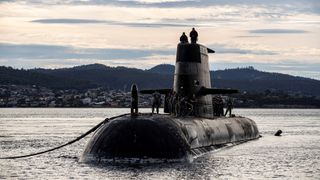Much of the commentary about the AUKUS (Australia, United Kingdom, United States) partnership since it was announced a year ago on Thursday has focused on when and if Australia will see nuclear-powered submarines in service.
Given the distant timeline, many strategists have instead turned their focus to AUKUS’s second pillar on advanced defence capabilities which will be the main deliverables for this decade. With projects on autonomous systems and hypersonic missiles among others, this trilateral collaboration will be consequential for tomorrow’s battlefield.
Notwithstanding pillar two, AUKUS will ultimately be judged by whether the submarine endeavour succeeds or fails. The sharing of nuclear propulsion technology is what sets the trilateral partnership apart from Australia’s already robust defence industrial and technological co-operation with the United States and the United Kingdom as well as US partnerships with other allies. It is this capability that has sparked intense regional interest, misunderstanding and no shortage of misinformation.
Defence Minister Richard Marles wants to bring the arrival date for the first submarine as far forward as possible. Equal attention should, however, also be given to when all eight submarines will be in service. Estimates vary widely depending on what kind of build configuration is ultimately chosen, but sometime in the mid-2050s is likely for the last submarine to be in the water. This is the full operational capability date that matters.
That is a long way into the future to base defence planning: a completely different world in many respects. To put this in context, the time before the last submarine is commissioned will be similar to the time just elapsed between the present and the Hawke government’s influential Defence White Paper of 1987.
Paul Dibb’s 1986 Review of Australia’s Defence Capabilities, which was the foundation for the following year’s White Paper, concluded by trying to look just 15 years into the future to the turn of the 21st century. He concluded “The military power and intentions of large Asian countries are imponderable over such a long timescale. No useful purpose, in defence planning terms, is served by speculating on these matters.”
In 1987, the United States was the region’s undisputed hegemon and no great power rival was on the horizon. The Soviet Union would collapse shortly afterwards. China was still emerging from years of instability. India’s economy was on par with Australia’s. Thirty-five years later, the strategic environment is radically different.
Submarines have demonstrated remarkable longevity throughout the technological revolution in military affairs.Vice Admiral Mark Hammond, Chief, Royal Australian Navy
It is only prudent to expect that there will be yet more surprises in store between now and the 2050s. The security challenges posed by an increasingly hostile China may underpin the logic behind Australia’s turn to nuclear-powered submarines, but the actual environment in which these vessels will operate is harder to guess, and indeed imponderable in many respects.
A few things can nonetheless be predicted with some measure of confidence. For one, Australia will be a very different country by the 2050s. We will be a bigger country, with 30 to 40 million people, and a more culturally and demographically diverse country.
In the words of the late Australian scholar Coral Bell, Australia will also be “living with giants”. This will be a region where Indonesia is economically larger than Japan and countries like Vietnam will have far greater strategic heft than they do today. Great power rivalries will be more complex in this multipolar regional order.
Technological progress will also have accelerated. There will be humans on the Moon and probably Mars, and they won’t just be American, marking the start of interplanetary strategic competition. Many Cold War-era “legacy” systems like surface ships, combat aircraft, and armoured vehicles will have either been made redundant or reimagined to work alongside artificial intelligence and unmanned systems.
This is the world in which the AUKUS partnership must be able to deliver nuclear-powered submarines that advance Defence’s strategic objectives, which may very well evolve and look different today.
As Australia’s new Chief of Navy, Mark Hammond, has noted, submarines have demonstrated remarkable longevity throughout the technological revolution in military affairs. Under sea warfare remains a critical strength for the United States and its allies, both in the Indo-Pacific and globally.
But the region’s current pace of naval shipbuilding and capability modernisation means that Australia’s eight submarines will have their work cut out in the contested, and congested, Indo-Pacific maritime theatre of the 2050s.
In the next 12 months, the Australian Government’s diplomatic stakes in the AUKUS partnership will soon require a major commitment of dollars to make it count. It will be a staggering amount given the unprecedented and national scale of this endeavour.
Any major defence procurement is a demanding task akin to hitting a distant moving target in a hazy sunset. But to paraphrase the 1986 Dibb Review, the threatening trends are now evident, military capacities are being built, and political tensions are rising. Australia needs to hit the bullseye.




